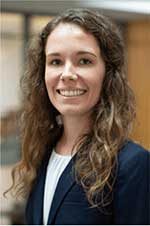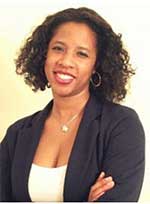Harvard Biostatistics Welcomes Two Assistant Professors
This article originally appeared in Biostats Briefing, a weekly newsletter from the department of biostatistics at the Harvard T.H. Chan School of Public Health. Both women will start their new positions on July 1.
Rachel Nethery
Assistant Professor of Biostatistics
What led to your decision to join Harvard biostatistics?
I was fortunate enough to join the department two years ago as a postdoc with Francesca Dominici, and during this time, I have developed a strong connection to and appreciation for this department. The faculty, staff, and students in the department are not only brilliant and passionate about their work but also have great attitudes and really make day-to-day life in the department pleasant and fun. Both within the department and across the university, Harvard offers unparalleled opportunities for collaboration with researchers doing groundbreaking work in all areas of health and medicine, making it one of the most exciting places in the world to work.
Because I don’t want to mislead you into thinking that all of my ideals are lofty, I should acknowledge that my love for the department is not independent of the high frequency of pizza parties (and other social events with food) that occur here.
Having formed this connection to the Harvard biostats environment as a postdoc, I was delighted and humbled to receive the opportunity to join this department as faculty, and I look forward to continuing to work (and chat by the coffee machine and enjoy leftovers in the kitchen) with you all.
Where did you grow up? Can you point to something in your life that may have influenced your decision to study biostatistics?
I grew up on a farm in rural Kentucky. Although few people there had any post-secondary business or mathematical training, most of the farmers managed their own finances and emphasized to me the importance of quantitative skills. My fantastic high-school calculus and physics teachers, Mrs. Parritt and Mr. Cox, get credit for my inspiration to pursue a quantitative career. Their enthusiasm about math was contagious, and their classes got me excited about using math to solve real-world problems.
During college, a professor (Mahlet Tadesse, a Harvard biostats alum) encouraged me to attend SIBS, a summer biostatistics program offered at several universities across the US. I went to SIBS at Emory University, where I was introduced to spatial modeling by Lance Waller and infectious disease modeling by Michael Haber. The incredible experience I had there motivated me to pursue a graduate degree
in biostatistics.
What was your previous educational and work experience before joining the department?
Fun fact: My first “real” job was as a cashier at Walmart. Moving on to more relevant experiences, I went to undergrad at Georgetown University, majoring in math and political science. Afterward, I went directly into the biostatistics PhD program at The University of North Carolina at Chapel Hill. I completed my PhD there in 2017 and then came to Harvard to do a postdoc with Francesca Dominici.
What do you enjoy most about your job so far, and what research directions are you planning to pursue?
Hands down, the best part of my current job is the incredible people that I get to work with in Francesca Dominici’s group. During my postdoc, I have primarily worked on causal inference methods for environmental health. Because environmental health studies are observational, drawing causal conclusions from them typically requires strong assumptions. Yet, in order for our science to inform environmental regulatory policy or to help bring justice to those impacted by pollution/contamination, it is critical that our results rely on as few untestable assumptions as possible. My research is focused on developing methods to assess and relax those assumptions across a variety of study types and research questions. I enjoy working on this topic due to its potential for direct policy and social impact. Moving forward, I hope to develop better methods to investigate relationships between disease clusters and contaminant exposures and to evaluate the health impacts of environmental regulatory policy.
What do you enjoy outside of work?
I spend much of my free time traveling to visit family and friends in the southeast. When I am in Boston, I enjoy exploring the city and surrounding areas and trying out new restaurants. I love bluegrass/folk/Americana music, and I try to go to live shows regularly. I also enjoy participating in politics, knitting, riding horses, and playing card games.
Briana Stephenson
Assistant Professor of Biostatistics
Briana had an affinity for mathematics and science since she was very young. Having matriculated through the public schools in her hometown of Columbia, Maryland, Briana attended the Massachusetts Institute of Technology (MIT), where she earned a Bachelor of Science degree in mathematics. At MIT, Briana was a member of the varsity volleyball team and an avid leader of both the Black Students’ Union and Delta Sigma Theta Sorority—a national public service organization.
Briana’s interest in biostatistics was not a linear one. Majoring in math and pre-med in college, she wrestled with how to mesh her two passions that would best augment her interests. As a first-year medical student, during a biostatistics seminar, it became painstakingly clear to Briana that she was in the wrong place. She abruptly withdrew from medical school and shifted her focus to biostatistics. While Briana needed to come to this discovery on her own, it was right under her nose the whole time. Both her mother and late aunt had careers in public health and were also biostatisticians. The apple had not fallen far from the tree.
While pursuing a Master in Public Health (MPH) degree in biostatistics at The George Washington University Milken Institute School of Public Health, Briana worked as a mathematical statistician at the Food and Drug Administration. She worked as an ORISE biostatistics research fellow for the Department of Defense in psychological health and strategic operations after earning her MPH. As a fellow, her interest in population health awakened. The methodological challenges encountered with large population data motivated her to increase her knowledge in the field and return to school. She enrolled in the biostatistics program at The University of North Carolina at Chapel Hill.
As a PhD student, Briana worked with Amy Herring. Briana’s research focused on Bayesian nonparametric clustering approaches to nutritional epidemiology. Her work earned her both national and international recognition, as well as the UNC Gillings’ Dissertation Award for Public Health Impact.
Currently, Briana is completing her postdoctoral research at the UNC Collaborative Studies Coordinating Center, working on the Hispanic Community Health Study/Study of Latinos with Jianwen Cai and Daniela Sotres.
Having enjoyed teaching both undergraduate and graduate students, a career in academia was a natural fit for Briana, providing her the unique opportunity to merge her interests in mentoring students with research and collaboration across myriad fields. The intersection of these areas is what captivated Briana’s interest in Harvard’s biostatistics department. Briana describes this intersection as an “all-you-can-eat buffet” of public health opportunities. On joining the biostatistics department, Briana said, “I am humbled to join the Harvard T.H. Chan family and call this amazing group of world-renown faculty and researchers my colleagues.”
At Harvard, Briana plans to continue her work creating innovative model-based clustering techniques that will accommodate the complexities of continually diversifying populations such as the United States. She is excited to return to the Boston area and work “on the other side of the river,” where her educational journey began.
In her spare time, Briana leads a high-school girls empowerment program through her sorority and serves as an assistant superintendent and teacher in her local church school. She also enjoys playing volleyball, practicing yoga, binge-watching TV, and, most recently, playing Settlers of Catan with her family.



















